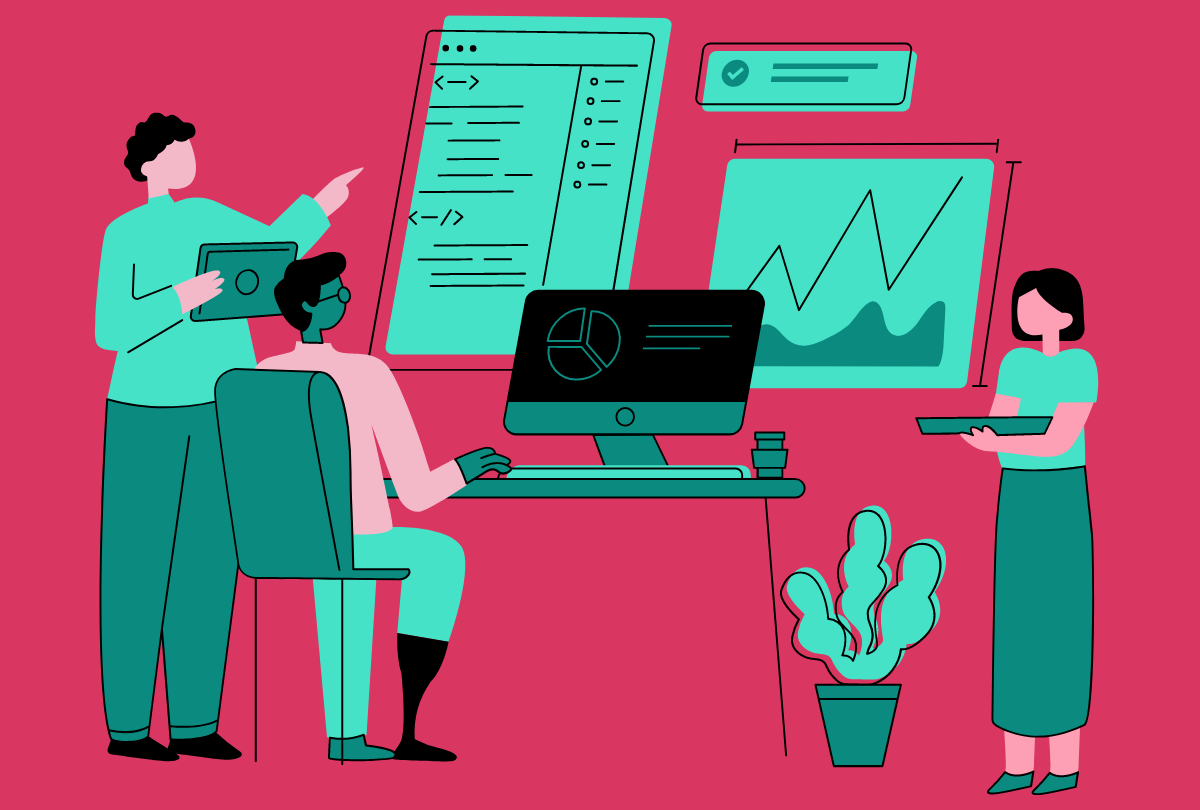
Career Ladder
Creating career ladders is a fundamental part of planning for the future. It’s equally essential for both employers and employees, as it saves enormous business resources while making employees feel that they are advancing. Personalized L&D courses play a key role in developing a worker’s confidence in their eventual promotion.
What Is a Career Ladder?
A career ladder (or corporate ladder), as its name suggests, is a designated path toward certain senior positions within an organization. A typical career ladder follows these upward steps:
- New hire
- Staff
- Senior staff
- Manager
- Senior manager
- Executive/Partner
At each stage, the employee gains responsibilities, is subject to higher expectations, and manages more people. But, as they move up, they also receive better pay, benefits, and prestige.
Of course, to advance, the employee needs to show competence in their role. And at a minimum – before becoming a manager – an employee must also prove that they are highly effective at their job.
There are other qualifications as well for climbing the career ladder. Leadership skills help, as does a record of L&D courses and professional certifications. Many companies with DEIB programs will choose to promote people from disadvantaged communities. Taking part in social initiatives and maintaining good relationships throughout the company can also strengthen a person’s profile to put them first in line for promotion.
How to Design a Career Ladder
Designing a corporate ladder for employees is no small task. But if your company is already involved in initiatives like career pathing, skill gap analysis, and continuous development, chances are that a lot of the groundwork has already been done.
In this sense, some HR professionals use a career ladder more as a visual tool than as a procedure. You can use a career ladder as a simple way to see an employee’s progression up the ranks. If the career ladder is made for this purpose, it will likely not include all of the details that can be found, for instance, in a skills gap analysis.
Here are the key steps of creating a career ladder:
1. Define the Career Goal and Related Experience/Skills
Where does your employee want to end up, and what are the senior roles in the company? With such a list in hand, research those positions and interview the people who currently fill them. This process will result in a roadmap that contains:
- Educational qualifications
- Path of advancement through the organization
- Experience outside of the organization (if the employee was an outside hire)
- Learning and development history
- Skill requirements (don’t forget soft skills!)
2. Plan for the Next Step
There is bound to be a waiting period before the employee is ready to move up. During this time, the worker should:
- Receive training in areas where identified skills are weak or absent
- Gain opportunities for job shadowing, cross-functional training, and leadership
- Work with a mentor and get advice on best practices for their next role
3. Establish Accountability
Ensuring that an employee gets the chances they need is often up to HR and/or the employee’s direct manager. If and when these people move to other roles, it is vital for their replacement to take over the development process. It is also a wise idea to check in periodically regarding the employee’s activities, and include their efforts as part of performance reviews, both of which can be a strong motivator.
Why Are Career Ladders Important?
A career ladder gives employees both a goal and a clear way of achieving it. Beyond that advantage, career ladders also help HR to support those goals in an organized manner. Together, these factors boost employee engagement, morale, and retention.
From the company’s perspective, career ladders are highly valuable. Through internal hiring of qualified employees, companies save the resources that would otherwise be spent on external recruiting. They also receive a supply of replacements for advanced roles who are already known in the organization. It’s similarly easier to fill vacancies, even when temporary, with employees who already have the proper background.
A Note on the Career Lattice
Not every employee makes it up the career ladder. But you can still provide valuable experiences to workers through a career lattice, which focuses on both upwards and sideways movements. For instance, a marketing associate might move within the department to customer support and then sales before a move up to becoming a marketing manager. The goal is to provide experience and expand skills, as employees at higher levels turnover or get promoted.
Employee “Career Ownership”
HR plays a vital role in managing employee careers, but they’re not the only ones. The concept of career ownership states that it’s also up to workers to figure out where they want to go and make sure they get there.
In other words, HR and employees need to team up for successful career development. The HR department should let their people know about all the programs that are available to help them advance. This can happen during onboarding, periodic organizational career days, during performance review sessions, and through the advising of direct managers.
For their part, employees should be encouraged to be proactive in their development. For instance, they could take part in:
Advanced Education
Workers can independently enroll in external courses, workshops, and educational programs. Nowadays, many professional courses are online and available for free. They are also self-paced and often assume that the viewer is starting to learn about the topic from the beginning so that the initial material is simple to understand.
Job Crafting
Job crafting is when employees look for ways to shift or expand their current tasks and their career path. This might happen outside of their formal career plan. In addition, job crafting does not always mean a dramatic change of professional goals. An employee who tries it can simply experiment with various roles and new projects as a way of “testing the waters”.
Networking
Both inside and outside an organization, employees can build an extensive contact network that leads to greater opportunities. Workers might join professional associations, connect with others on LinkedIn, and simply get to know people around the office.
Support Programs
Mentoring, manager feedback, and department meetings are just a few of the ways for employees to improve how they do their job and find out about opportunities in the company. As opposed to networking, support programs are a formal part of work procedures, but it’s up to the employee to use them as a springboard for professional advancement.
These are just some of the ways that employees can gain skills and connections at a much faster rate than if they had relied on internal L&D and HR programs alone. This will ultimately improve their ability to move up the corporate ladder more quickly.
Making the Most of Corporate Ladders
On their own, career ladders do not always provide all of the benefits listed above, mostly because the employee does not get a chance to move up. At times, the organization is at fault; and at others, the employee does not have the right mindset.
Employees
One of the assumptions behind a career ladder is that there are multiple layers of hierarchy and that it takes time to rise to the top. For some employees, the wait might be too long. While waiting to advance, high-performing workers may be presented with outside opportunities and make a jump to another company. In fact, “low pay” and “lack of advancement” are among the top reasons for employees to quit.
But today’s companies are starting to understand that productivity is often the result of skills. In turn, many are adopting flat hierarchies and role-based promotions. For example, instead of promoting somebody with great communication skills to the position of chief marketing officer, a company will assign them to work on several teams as a specialist. This allows the employee to gain new skills and experience, and perhaps more importantly, understand that the company is investing in their development. Such a move hopefully convinces them to stay. Still, this is a strategic change that requires approval from the highest levels, as well as extensive reorganization.
Companies
Giving an employee a plan that shows how they can advance is only a temporary measure. If a worker takes all the recommended steps and still goes nowhere, poor morale and turnover will probably result.
This is not always preventable. If a company does not expand and/or if employees at higher levels stay put, there will ultimately be no opportunity to proceed up the ladder. But hiring practices are also to blame; companies prefer to hire from outside sources about 75% of the time.
HR can improve the situation through measures such as:
- Internal hiring
- Retention initiatives
- Dual career ladders and lateral mobility (as part of a career lattice)
- Learning and development programs
This last option in particular is really valuable. L&D is part of many initiatives that promote the advancement of employees from within. Through careful application of L&D programs, HR can give their people the abilities they need to outperform, get noticed, and enjoy climbing the corporate ladder.
Being Real About Career Ladders
As hinted above, frequent moves up the career ladder by many employees across a company is often beyond HR’s control. Cycles of expansion and contraction because of the economy, demand for your organization’s product, or the effects of strategy can take years. All of these will influence the number of open positions, and employees’ ability to reach their career goals.
But there is another factor that is very much within HR’s control, and that is professional development programs. Empowering your workers with new skills puts them in the best position to move, if and when they get the chance. For those who don’t make it up the ladder, L&D gives them the ability to find opportunities elsewhere. Don’t forget that ex-employees who enjoyed the experience at your company can be a resource by referring job candidates to you, providing good reviews on company sites, and even being useful contacts for business connections.
The responsibility of HR, even when few growth opportunities are available, is to keep the L&D going. For example, some of the top skills today for increasing the value of employees are:
Communication skills
Communication has always been one of the most critical skills for employees to develop because it affects a wide range of business activities. This includes verbal, written, interpersonal, and presentational abilities. Today, with the increase in work-from-home arrangements, employees must also master virtual communications.
Leadership skills
Leaders don’t need to be department heads or executives. The modern concept of leadership includes anybody who helps others, speaks up, or demonstrates expertise. Organizations can use leadership courses to identify where an employee already excels and help them nurture that ability.
Adaptability skills
The increasing importance of AI, economic disruptions, and a changing workforce all mean that employees will have to continuously learn new ways of doing business and cooperating with others. Adaptability training often uses simulations, role-playing, and workshops that emphasize interactivity as a means to both create and resolve challenges.
Building Careers with Growthspace
When it comes to designing L&D programs, the trick is knowing exactly which skills to develop for specific people. Each employee has their own set of strengths and weaknesses, and it’s beyond the ability of most businesses, especially large ones, to track and address personalized L&D requirements.
Not so with Growthspace. Through a platform that’s winning over HR/L&D departments in every industry, Growthspace matches domain experts to employees in the precise areas where they need development. Combined with intuitive assessment methods, Growthspace gives employees a spot-on boost up the career ladder.


